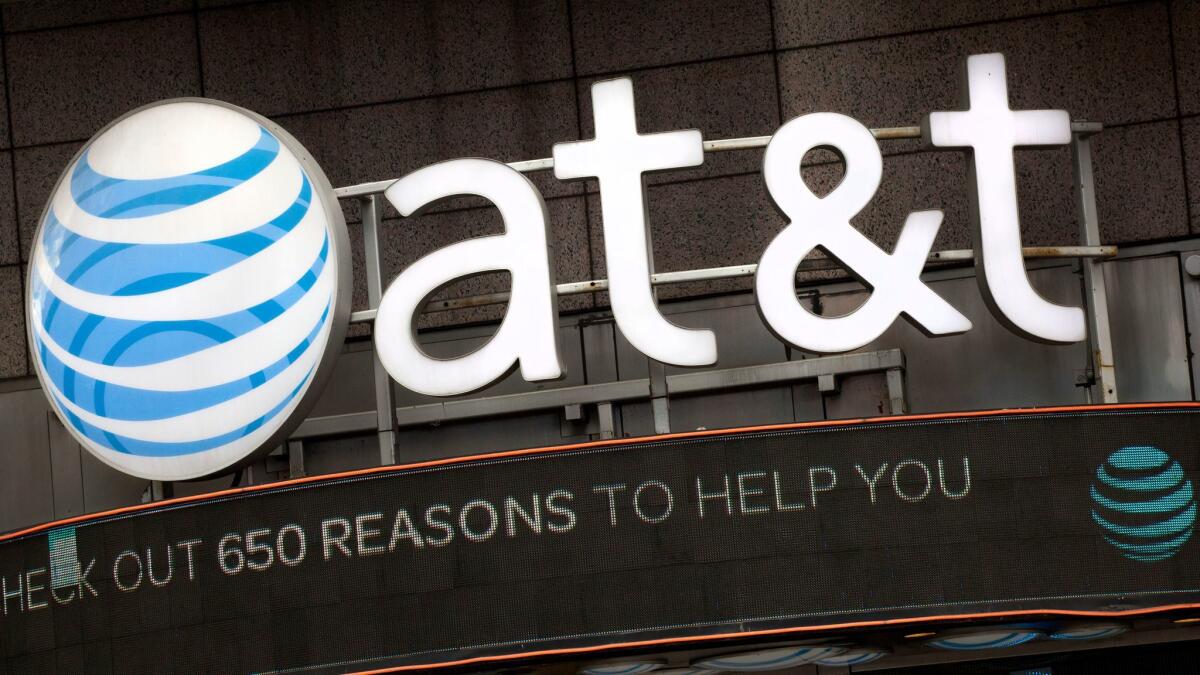Column: AT&T’s rollout of broadband serves the rich, shunts mid- and low-income families to the slow lane

The argument that the private sector can do things better, faster and cheaper than government never seems to go out of style.
But a new report on AT&T’s strategy for rolling out high-speed Internet service in California underscores what may be the biggest flaw in that argument: When critical infrastructure construction is left entirely to private companies, much of the public gets shortchanged.
The report, released Tuesday by UC Berkeley’s Haas Institute for a Fair and Inclusive Society, shows how AT&T, the largest telecommunications carrier in the U.S. and California, favored the wealthiest communities in rolling out its Internet service. The median income of households with access to AT&T’s fastest fiber-to-the-home service was $94,208 as of last June. That was some 50% higher than the statewide median income of about $61,800 (as of 2015).
What is really essential infrastructure for connecting people ... should be rolled out in the public interest and in an equitable way.
The median income of communities offered at best AT&T’s slower U-verse fiber-to-the-neighborhood broadband service was about $67,000. And among communities with access to no better than AT&T’s slow DSL service, the median income was only $53,186 — below the median income of the entire state.
Rural communities are especially disadvantaged in AT&T’s rollout, the report found. These have been “largely bypassed” even by AT&T’s U-verse deployment. The research underlying the report was funded by the Communications Workers of America.
Berkeley’s findings have much to tell us about the drawbacks of leaving the deployment of such important services to market forces.
“What is really essential infrastructure for connecting people to education, economic opportunity, business relationships and other really critical spheres of life should be rolled out in the public interest and in an equitable and inclusive way,” the report’s lead author, Eli Moore of the Haas Institute, told me. “Based on the data we analyzed, it does not appear that AT&T is doing that in low-income and moderate income communities.”
AT&T responded to the Berkeley study with what one might label a non-denial denial. “We don’t favor any demographic when it comes to providing any service we offer,” company spokesman Steven Maviglio said. “We would like nothing more than to serve every customer who wants our services.”
But he also said that in deciding where to build its network, AT&T chooses to “follow the demand for high internet speeds and determine where there are solid investment cases and receptive policies,” and prefers cities that have “established a strong environment for investing.”
By their nature, these are likely to be more affluent communities with residents who appreciate the benefits of high-speed communications because they have experience using them. But that also leaves behind communities whose residents don’t voice a demand for the best services because they don’t know what they’re missing—or who don’t have the money to buy the Internet-connected goods and services that put additional revenues in the ISP’s pocket. At its heart, this is a strategy in which the rich get richer—widening, not narrowing, the digital divide.
It’s not remarkable or surprising that AT&T would focus its highest-priced and potentially most lucrative service offerings at the wealthiest neighborhoods. One can’t blame a private company for responding to the profit motive any more than one can blame a dog for drinking from the toilet.
But that’s what government regulation is for — to ensure that a private company endowed by government with a largely monopolistic franchise compensate the community for its windfall in part by serving all residents equally. Think of it as the equivalent of keeping the dog’s nose out of the bowl.
That’s especially important given the immense commercial advantages being sought by big telecommunications companies. AT&T’s proposed $85-billion merger with Time Warner, the owner of CNN, HBO and other major news and entertainment sources, is currently under review by Washington regulators.
But regulators have been moving in the opposite direction. Although President Trump panned the merger while on the campaign trail, some federal agencies have taken on a distinctly pro-corporate cast since his inauguration. Trump’s FCC chairman, Ajit Pai, has said that he intends to reverse the commission’s 2015 “reclassification” of broadband service as a utility, rather than an “information service.”
The 2015 change was aimed at increasing the FCC’s oversight of ISP’s like AT&T; reversal would sharply limit the commission’s jurisdiction over ISP behavior, including its ability to prevent ISPs from favoring their own content on their transmission lines over that of competitors.
The California legislature tied its own regulators’ hands with a 2012 measure that rolled back the authority of the Public Utilities Commission over Internet providers. The measure, which was signed into law by Gov. Jerry Brown, was supported by AT&T, along with such other major Internet providers as Verizon, Time Warner Cable, Charter Communications and Cox Communications. (Time Warner Cable and Charter have since merged.)
The only way to force Internet providers to roll out the best services to everyone is to subject them to competition. That has been shown by the rapid response of incumbent ISPs, including AT&T, in communities where Google has shown up with its high-speed Google Fiber services — instantly, ISPs that offered nothing but slow and expensive service have discovered the capability of jacking up speeds and cutting prices. What was troubling, however, is that Google rolled out its highest-speed fiber service in a way that initially favored the most affluent neighborhoods in those communities, which include Austin, Texas; Provo, Utah; Kansas City, Mo.; and its neighboring namesake in Kansas.
Unfortunately, the Trumpian FCC also seems to take an indulgent view of what constitutes competition. Actually having two or more broadband providers operating in the same neighborhood is no longer required.
The answer to what the Berkeley report calls “AT&T’s digital divide in California” is to treat broadband as infrastructure to be built by government, like roads and bridges. But there are no indications as yet that it will be part of Trump’s supposed $1-trillion infrastructure plan. That plan, in any event, favors projects that can attract private investment — exactly the problem underscored by AT&T rollout strategy, which devotes the strongest firepower to communities that best serve the profit motive. The most aggressive moves may come at the municipal level, such as San Francisco’s idea for a municipal broadband network.
Companies such as AT&T want to keep control of this crucial market while serving it in their own interest, not the public interest. The harvest so far has been crummy service for too many Americans, at a price few can easily afford.
Keep up to date with Michael Hiltzik. Follow @hiltzikm on Twitter, see his Facebook page, or email michael.hiltzik@latimes.com.
Return to Michael Hiltzik’s blog.
UPDATES:
5:10 p.m.: This post has been updated with extended remarks from AT&T.
More to Read
Inside the business of entertainment
The Wide Shot brings you news, analysis and insights on everything from streaming wars to production — and what it all means for the future.
You may occasionally receive promotional content from the Los Angeles Times.











